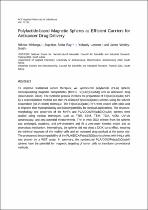 ResearchSpace
ResearchSpace
Polylactide-based magnetic spheres as efficient carriers for anticancer drug delivery
JavaScript is disabled for your browser. Some features of this site may not work without it.
- ResearchSpace
- →
- Research Publications/Outputs
- →
- Journal Articles
- →
- View Item
| dc.contributor.author |
Mhlanga, N

|
|
| dc.contributor.author |
Ray, Suprakas S

|
|
| dc.contributor.author |
Lemmer, Yolandy

|
|
| dc.contributor.author |
Wesley-Smith, J

|
|
| dc.date.accessioned | 2016-02-23T08:37:32Z | |
| dc.date.available | 2016-02-23T08:37:32Z | |
| dc.date.issued | 2015-09 | |
| dc.identifier.citation | Mhlanga, N. et al. 2015. Polylactide-based magnetic spheres as efficient carriers for anticancer drug delivery. ACS Applied Materials & Interfaces, vol. 7(40), pp 22692-22701 | en_US |
| dc.identifier.issn | 1944-8244 | |
| dc.identifier.uri | http://pubs.acs.org/doi/10.1021/acsami.5b07567 | |
| dc.identifier.uri | http://hdl.handle.net/10204/8384 | |
| dc.description | Copyright: ACS Publications. Due to copyright restrictions, the attached PDF file only contains the abstract of the full text item. For access to the full text item, please consult the publisher's website. The definitive version of the work is published in ACS Applied Materials & Interfaces, vol. 7(40), pp 22692-22701 | en_US |
| dc.description.abstract | To improve traditional cancer therapies, we synthesized polylactide (PLA) spheres coencapsulating magnetic nanoparticles (MNPs, Fe(sub3)O(sub4)) and an anticancer drug (doxorubicin, DOX). The synthesis process involves the preparation of Fe(sub3)O(sub4) NPs by a coprecipitation method and then PLA/DOX/Fe(sub3)O(sub4) spheres using the solvent evaporation (oil-in-water) technique. The Fe(sub3)O(sub4) NPs were coated with oleic acid to improve their hydrophobicity and biocompatibility for medical applications. The structure, morphology and properties of the MNPs and PLA/DOX/Fe(sub3)O(sub4) spheres were studied using various techniques, such as FTIR, SEM, TEM, TGA, VSM, UV-vis spectroscopy, and zeta potential measurements. The in vitro DOX release from the spheres was prolonged, sustained, and pH-dependent and fit a zero-order kinetics model and an anomalous mechanism. Interestingly, the spheres did not show a DOX burst effect, ensuring the minimal exposure of the healthy cells and an increased drug payload at the tumor site. The pronounced biocompatibility of the PLA/DOX/Fe(sub3)O(sub4) spheres with HeLa cells was proven by a WST assay. In summary, the synthesized PLA/DOX/Fe(sub3)O(sub4) spheres have the potential for magnetic targeting of tumor cells to transform conventional methods. | en_US |
| dc.language.iso | en | en_US |
| dc.publisher | ACS Publications | en_US |
| dc.relation.ispartofseries | Workflow;16165 | |
| dc.subject | Traditional cancer therapies | en_US |
| dc.subject | Polylactide spheres | en_US |
| dc.subject | PLA | en_US |
| dc.subject | Doxorubicin | en_US |
| dc.subject | DOX | en_US |
| dc.subject | Fe304 nanoparticles | en_US |
| dc.subject | Magnetic spheres | en_US |
| dc.subject | Anticancer drug | en_US |
| dc.subject | Magnetic targeting deliver | en_US |
| dc.subject | Invitro study | en_US |
| dc.title | Polylactide-based magnetic spheres as efficient carriers for anticancer drug delivery | en_US |
| dc.type | Article | en_US |
| dc.identifier.apacitation | Mhlanga, N., Ray, S. S., Lemmer, Y., & Wesley-Smith, J. (2015). Polylactide-based magnetic spheres as efficient carriers for anticancer drug delivery. http://hdl.handle.net/10204/8384 | en_ZA |
| dc.identifier.chicagocitation | Mhlanga, N, Suprakas S Ray, Yolandy Lemmer, and J Wesley-Smith "Polylactide-based magnetic spheres as efficient carriers for anticancer drug delivery." (2015) http://hdl.handle.net/10204/8384 | en_ZA |
| dc.identifier.vancouvercitation | Mhlanga N, Ray SS, Lemmer Y, Wesley-Smith J. Polylactide-based magnetic spheres as efficient carriers for anticancer drug delivery. 2015; http://hdl.handle.net/10204/8384. | en_ZA |
| dc.identifier.ris | TY - Article AU - Mhlanga, N AU - Ray, Suprakas S AU - Lemmer, Yolandy AU - Wesley-Smith, J AB - To improve traditional cancer therapies, we synthesized polylactide (PLA) spheres coencapsulating magnetic nanoparticles (MNPs, Fe(sub3)O(sub4)) and an anticancer drug (doxorubicin, DOX). The synthesis process involves the preparation of Fe(sub3)O(sub4) NPs by a coprecipitation method and then PLA/DOX/Fe(sub3)O(sub4) spheres using the solvent evaporation (oil-in-water) technique. The Fe(sub3)O(sub4) NPs were coated with oleic acid to improve their hydrophobicity and biocompatibility for medical applications. The structure, morphology and properties of the MNPs and PLA/DOX/Fe(sub3)O(sub4) spheres were studied using various techniques, such as FTIR, SEM, TEM, TGA, VSM, UV-vis spectroscopy, and zeta potential measurements. The in vitro DOX release from the spheres was prolonged, sustained, and pH-dependent and fit a zero-order kinetics model and an anomalous mechanism. Interestingly, the spheres did not show a DOX burst effect, ensuring the minimal exposure of the healthy cells and an increased drug payload at the tumor site. The pronounced biocompatibility of the PLA/DOX/Fe(sub3)O(sub4) spheres with HeLa cells was proven by a WST assay. In summary, the synthesized PLA/DOX/Fe(sub3)O(sub4) spheres have the potential for magnetic targeting of tumor cells to transform conventional methods. DA - 2015-09 DB - ResearchSpace DP - CSIR KW - Traditional cancer therapies KW - Polylactide spheres KW - PLA KW - Doxorubicin KW - DOX KW - Fe304 nanoparticles KW - Magnetic spheres KW - Anticancer drug KW - Magnetic targeting deliver KW - Invitro study LK - https://researchspace.csir.co.za PY - 2015 SM - 1944-8244 T1 - Polylactide-based magnetic spheres as efficient carriers for anticancer drug delivery TI - Polylactide-based magnetic spheres as efficient carriers for anticancer drug delivery UR - http://hdl.handle.net/10204/8384 ER - | en_ZA |





